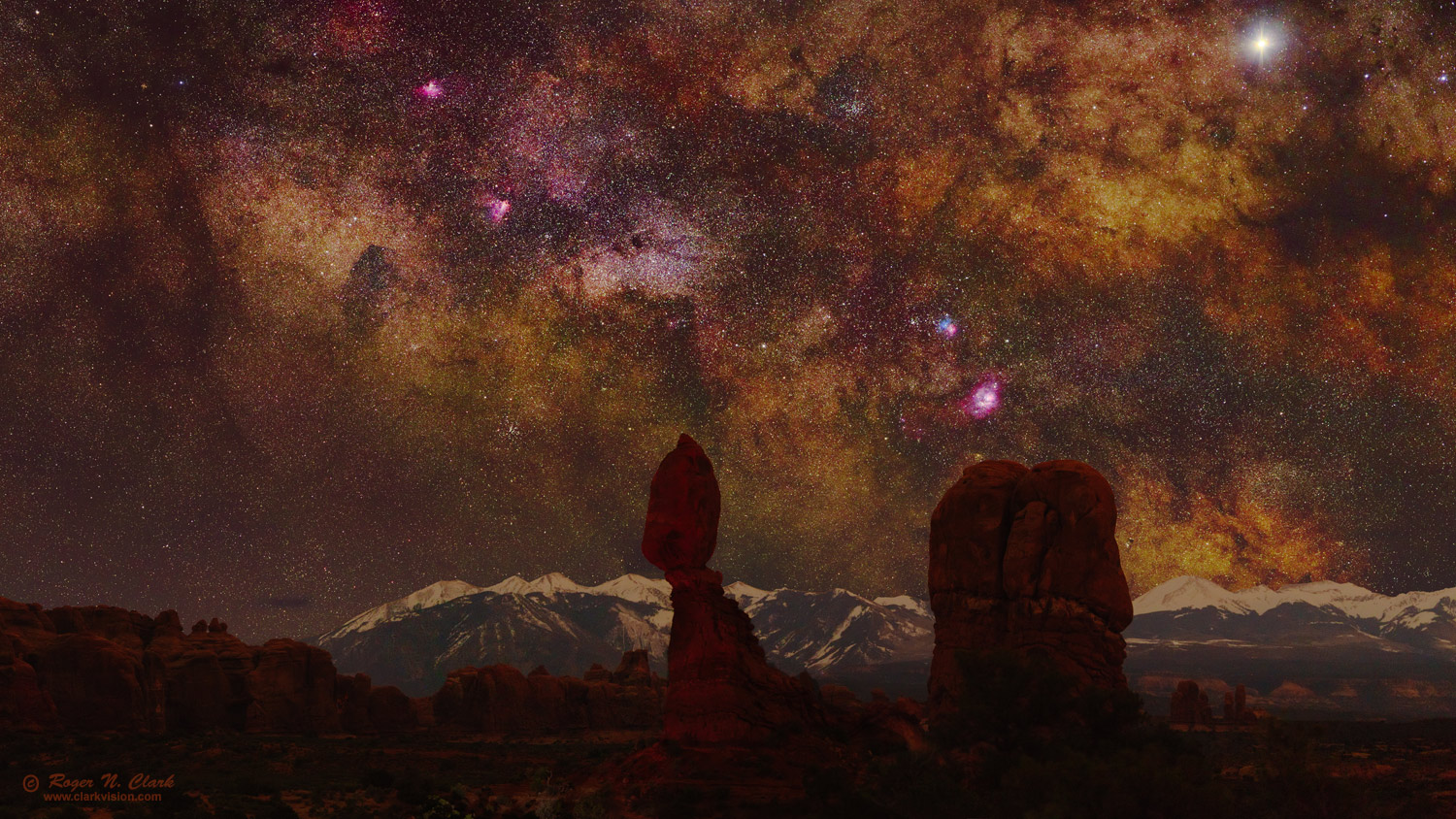| Home | Galleries | Articles | Reviews | Best Gear | New | About | Contact | Gallery Index | Previous |
Next |

| Home | Galleries | Articles | Reviews | Best Gear | New | About | Contact | Gallery Index | Previous |
Next |

Milky Way star clouds and the galactic core region rise above the La Sal Mountains and Balanced Rock, Arches National Park, Utah. While these star clouds are visible to the unaided eye, a pair of large binoculars will begin to show the wonders seen here. There are 4 large hydrogen emission nebulae in the scene, numerous star clusters, faint red hydrogen emission nebulae, burnt-orange interstellar dust, dark dusty regions and millions of stars, most yellower and redder than our sun. Jupiter is the bright object at upper right. The reddish-pink hydrogen emission nebulae are from lower right to upper left: Messier 8, the Lagoon nebula (the brightest of the 4), Messier 20, the Trifid nebula with a blue component caused by Rayleigh scattering, Messier 17, the Omega nebula, and Messier 16, the Eagle nebula with the Pillars of Creation. The sky background includes some reddish and greenish airglow, otherwise the dark dust would appear even darker. The galactic plane of the Milky Way runs from top left to lower right.
This image was made with a stock digital camera and processed to bring out the wonderful natural colors in the region.
Technical. This image is a 5-frame mosaic, made from 7 images, obtained with a Canon EOS 6D Mark II DSLR Camera and Sigma 105mm f/1.4 DG HSM Art Lens at f/1.4 and ISO 1600, 30 second exposures. Two positions were imaged for the land, and two 30-second exposures were obtained at each position and stacked to reduce noise. The sky was tracked, 30 second exposures and 3 frames were mosaicked (no stacking). Three frames were required to record stars before they moved behind the landscape and after other stars came out. This way the images could be aligned to a common point in time to show the stars without any blur or gaps around the mountains and rocks. No dark frame subtraction, no flat fields. Tracking with a Fornax Lightrack II and no guiding. The total exposure was 3.5 minutes. The full resolution image plate scale is 11.2 arc-seconds per pixel, and 9111 x 4415 pixels (40 megapixels). The original field of view is 28 x 13 degrees, slightly smaller in this presentation.
Post processing: Raw conversion with Rawtherapee with settings tuned for astrophotos, including maintaining star color in saturated stars. Rawtherapee processing settings described here. Output color space was Rec.2020 to match the future of high dynamic range TVs. Look for a future article on this topic. Stretched with rnc-color-stretch. Also see Astrophotography Image Processing Basic Work Flow.
This is a natural color image. The high dynamic range of astrophotos must be stretched to bring out the range of details the camera recorded. But the typical image stretch process loses color for brighter subjects (e.g. stars and the brighter parts of deep sky objects become whiter as they are made brighter). This image uses a new algorithm that does not lose color during the stretch. The new algorithm enables fainter details to be shown and with less noise. Learn about the new software and download it free (open source) here: rnc-color-stretch. Accurate color at the low end depends on accurately subtracting airglow and light pollution.
Realize that the Milky Way is actually quite low in the sky. The Lagoon Nebula, M8, for example, is only 7.6 degrees above the true horizon (less above the mountain tops). That low in the sky, everything is reddened. I checked some star colors, and even faint magnitude 13.6 stars have consistent color for the altitude of the stars and white stars are only yellowish. Being a nightscape, while I subtract some airglow for improved contrast, and there was a lot of red airglow, but I don't correct for atmospheric absorption. This is similar to a setting sun near sunset: I don't correct for atmospheric absorption and make the sun white. So the red color is reasonably consistent for natural color and for the conditions with everything low in the sky.
The Exposure Factors, CEF, CEFA are measures of the relative amounts of light received from a subject. It can be used to fairly compare wildly different lens/telescope apertures and exposure times. For this image:
Modern DSLRs like the 6D Mark II include on sensor dark current suppression and low fixed pattern noise at ISOs around 1600 and higher, making no need for dark frame subtraction. Modern raw converters correct for light fall-off and also correct for hot/dead/stuck pixels. This makes processing low light images easy: simply align and average.
To learn how to obtain stunning images like this, please visit my Extensive Articles on Photography .
Keywords to this image = nightscapes landscape-1 mosaic night low-light digital_astro mountains utah archesNP canon_6D2
Image ID: balanced-rock-arches-rnclark-105mm-c05-03-2019-IMG_6379-6415.g-c1-1500s.jpg
| Home | Galleries | Articles | Reviews | Best Gear | Science | New | About | Contact |
Last updated November 03, 2025